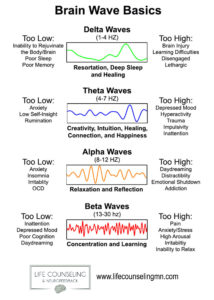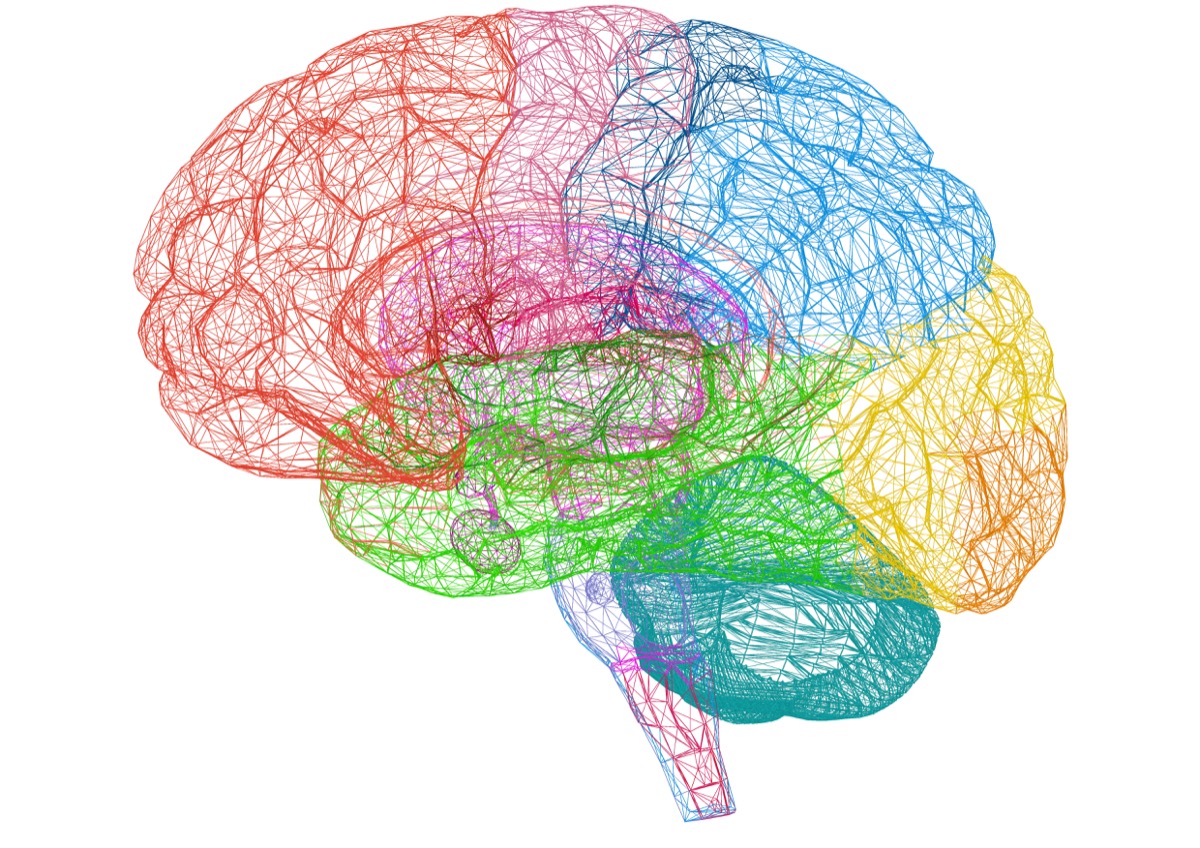What is Neurofeedback?
At L.I.F.E. Counseling and Neurofeedback, we use a 19 channel cap set-up which follows the international 10-20 system of EEG placement and the most up to date software available in order to train deep areas of the brain including the cingulate and cerebellum.
We use SW Loreta software which allows us to address three areas of potential dysregulation. These three areas include amplitude or the amount of energy the brain is producing and using, coherence which is how well the brain is communicating between specific areas of the brain (called Brodmann areas), and phase lag which looks at the amount of time it takes for a message to go from one Brodmann area to the next.
At L.I.F.E Counseling and Neurofeedback we believe in a holistic approach to wellness. In addition to neurofeedback training, we encourage participants to consider individual counseling and nutrition counseling to provide the most comprehensive approach to their wellness possible. LIFE counseling has several counselors available to speak with as well as a registered dietitian who is part of the neurofeedback team.
At L.I.F.E Counseling and Neurofeedback we want you to feel connected and to feel confident that this is the right fit for you from the start. So, we offer a free 20-minute consult with our Director and Board Certified Neurofeedback provider, Brad Bychinski.
- 20-minute free consult
- 2 hour intake appointment with Qeeg and brief verbal interpretation
- testing appointment as needed (times vary)
- 1 hour debrief appointment to discuss findings and suggestions to move forward.
Alleviating Symptoms of:
Anxiety
Attentional Deficit/Hyperactivity Disorder
Autism Spectrum Disorder
Bipolar Disorder
Chronic Pain
Compulsive Behaviors
Depression
Irritability/Emotional Regulation
Learning Disabilities
Mild -Traumatic Brain Injury
Obsessive Compulsive Disorder
Post-Traumatic Stress Disorder
Sleep Difficulties
For those looking to stay sharp and gain an extra advantage
Mental Stamina
Productivity
Performance
Memory
Focus
Calm/Patience
Myth 1: Neurofeedback lacks scientific support.
Fact: On the contrary, there are hundreds of peer-reviewed published studies from reputable journals with support from neuroscientists worldwide and the numbers continue to grow. Several groups and journals continue to demonstrate the efficacy of Neurofeedback, such as: International Society of Neuronal Regulation, International Society for Neuroregulation and Research, Clinical EEG and Neuroscience Journal, Applied Psychophysiology and Biofeedback.
As the body of research continues to grow and the interest and understanding of how the brain functions becomes more widespread, Neurofeedback has demonstrated its efficacy in a variety of mental health and peak-performance situations.
Myth 2: By engaging in Neurofeedback I can learn to control my own brain waves.
Fact: One of the beauties of Neurofeedback is that it is more of a passive than active activity for the client. Neurofeedback is a form of operant conditioning for electrical activity within the brain. When engaged in neurofeedback, the brain learns to change patterns and seeks greater efficiency through operant conditioning; in our case, learning that occurs through a reward system. The brain learns, through focused and repeated reward, to communicate in a more calm or focused pattern. Similar to learning a new skill, the brain is learning through repeated practice and reward. This learning is not something the individual engaged in Neurofeedback can consciously learn or manipulate. Through the process of operant conditioning, the brain learns how to become unstuck from patterns it has previously used and to be more flexible.
Myth 3: If I don’t notice change in the first few weeks, Neurofeedback won’t work for me.
Fact: Our brains are all wired uniquely. Some will respond quickly, within a few sessions, while others may not notice a change for several weeks. While most will see statistically significant change, it is important to note about 15% of people pursuing neurofeedback may find little to no changes in symptoms. We found that those who are more relaxed and not trying to control the frequency of rewards tend to see more desirable results. It is also important to note that Neurofeedback is not a cure but rather a tool that can lead to greater overall functioning and reduction of some symptoms. At LIFE Counseling & Neurofeedback, we understand the importance of a wholistic approach. The brain/gut connection and the patterns of thinking/beliefs we carry as well as lifestyle choices surrounding diet, sleep and exercise all play a vital role in the environment in which learning can take place.
Myth 4: Neurofeedback can change my personality.
Fact: Neurofeedback does not change one’s personality, rather Neurofeedback enhances it by allowing for greater calm and focus of electrical activity within the brain. One can rediscover who they really are when anxiety, distraction or pain are not the focal point.
Myth 5: All forms of Neurofeedback are the same.
Fact: There are several forms of Neurofeedback which address different areas and train different aspects of neuronal activity. For example, some forms of Neurofeedback focus on training amplitude only while others may focus on coherence and phase. At LIFE Counseling & Neurofeedback we specialize in S-LORETA and SW-LORETA Neurofeedback, which is guided by a qEEG (map of the functionality of your brain) and uses 19 channel z-scores training to help direct the brain towards more calm and focus. Training focuses on amplitude, coherence (connectivity) and phase (speed) which also allows us to train the brain in networks or specific regions of functioning.
Myth 6: I can’t do Neurofeedback while taking medication.
Fact: Neurofeedback, medication, and supplements have their place in helping the brain function at a more optimal level. Medication and Neurofeedback can work together, and at times when the brain learns to function more efficiently, it is possible the brain can become less dependent on supplements or medication.
The brain is an AMAZING organ!
It is made up of 100 billion neurons that communicate with one another by means of electrical pulses (brain waves) which send neurotransmitters from one neuron to another. This electrical activity, when ‘under’ or ‘over’ performing, can produce a dysregulated state that impacts academic, emotional, social and physical areas of life. Some of this dysregulation can include symptoms of ADHD, addictions, anxiety, depression, head injuries and PTSD.
This is where Neurofeedback can help! The brain is capable of adapting and reorganizing (called neuroplasticity). Neurofeedback provides the brain the opportunity it needs to learn new pathways, helping it to perform more optimally. This happens through a process of rewarding electrical activity over and over and over again as it achieves a more desired state of relaxation or focus. This repetitive rewarding, also known as positive reinforcement, allows old pathways to lose their strength and allows for new pathways to grow and strengthen.
Brain Mapping and Analysis
We use a series of applications to image and study the functionality of your brain by looking at power, connectivity, and phase to better understand the nature of your current state of functioning.
Neurofeedback harnesses the brain’s ability to change and uses it to strengthen connections and bring the brain from a state of dysregulation into regulation.

